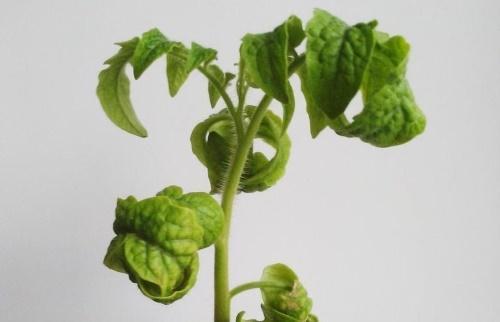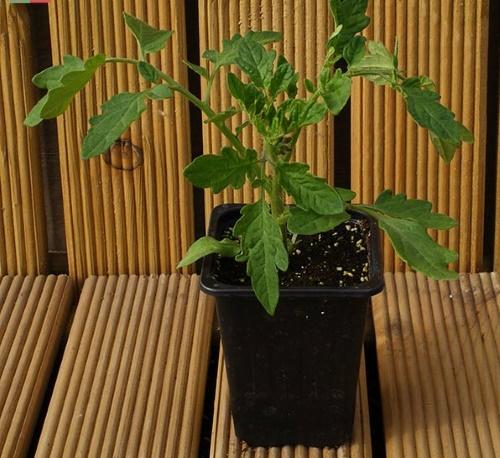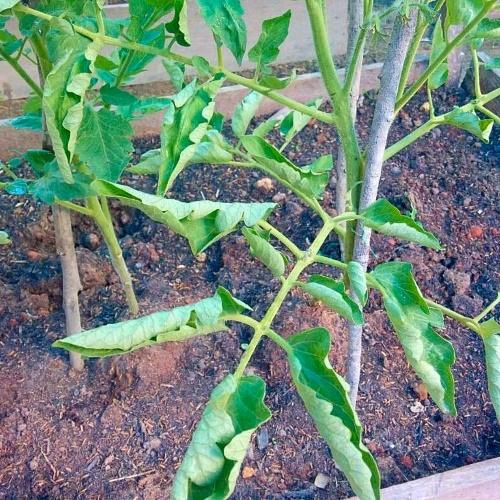Why do tomato seedlings curl leaves: causes and solutions to the problem
 As you know, the leaves of plants are an indicator of their health. If something is wrong, they immediately give a signal, changing their color or shape. Take tomatoes. There can be many reasons why the leaves of tomato seedlings curl, and this is not necessarily a disease. The condition of the seedlings is influenced by both the growing conditions of the seedlings and their care. For any deviation from the rules for growing seedlings, she will immediately answer you by folding leaf plates, changing the color or even dropping foliage.
As you know, the leaves of plants are an indicator of their health. If something is wrong, they immediately give a signal, changing their color or shape. Take tomatoes. There can be many reasons why the leaves of tomato seedlings curl, and this is not necessarily a disease. The condition of the seedlings is influenced by both the growing conditions of the seedlings and their care. For any deviation from the rules for growing seedlings, she will immediately answer you by folding leaf plates, changing the color or even dropping foliage.
Why does it happen and what to do? Depending on the specific situation, the reasons for this phenomenon may be:
- varietal features;
- too high a temperature;
- violation of the watering regime:
- lack or excess of food;
- wrong pinching.
Let's take a quick look at each point.
Why do tomato seedlings curl leaves and where does the variety belong?

A similar trait is inherent in varieties such as:
- cherry;
- Honey drop;
- Fatima;
- as well as most tall tomatoes.
Leaves curling due to heat
 If the leaves curl up into a boat only during the day and return to their normal shape at night, check the thermometer. At high temperatures, the seedlings thus instinctively reduce the evaporation area.
If the leaves curl up into a boat only during the day and return to their normal shape at night, check the thermometer. At high temperatures, the seedlings thus instinctively reduce the evaporation area.
Ventilate greenhouse tomatoes more often, and darken or rearrange those growing in the room.
How watering affects curl
 Everything is simple here: there is not enough moisture - the leaves curl down, the excess - up. Adjust watering, do not wait until the ground is completely dry, but do not make a swamp. In both cases, you will only harm the seedlings. Water frequently as soon as the top layer dries. But do it in small portions, taking into account the growing temperature and the rate of evaporation of moisture.
Everything is simple here: there is not enough moisture - the leaves curl down, the excess - up. Adjust watering, do not wait until the ground is completely dry, but do not make a swamp. In both cases, you will only harm the seedlings. Water frequently as soon as the top layer dries. But do it in small portions, taking into account the growing temperature and the rate of evaporation of moisture.
Nutrient imbalance
 Both the excess and the lack of individual trace elements negatively affect the overall development of seedlings. At the initial stage, it is important to feed the tomatoes with nitrogen. However, if there is a lot of it, the leaves thicken, but become fragile and wrap up in a ring. So switch to mineral complexes in time. In addition, complex preparations have a balanced composition, which will avoid a shortage or excess of other trace elements. What it is specifically can be determined by the "twisting character", namely:
Both the excess and the lack of individual trace elements negatively affect the overall development of seedlings. At the initial stage, it is important to feed the tomatoes with nitrogen. However, if there is a lot of it, the leaves thicken, but become fragile and wrap up in a ring. So switch to mineral complexes in time. In addition, complex preparations have a balanced composition, which will avoid a shortage or excess of other trace elements. What it is specifically can be determined by the "twisting character", namely:
- leaves fold and cast purple - there is not enough phosphorus;
- the top of the leaf twists, and he himself rolls down - a lack of zinc;
- young foliage turns downwards - lack of boron;
- in addition to folding, the leaves also turn pale - there is not enough calcium;
- the tips of the leaves turn upward, and they themselves turn yellow, become lethargic and sag - lack of iron.
Pinching too hard causes the leaves to roll
 Nobody argues that it would be convenient to remove all stepchildren on tomatoes at one time. However, this is too difficult a procedure that plants may not survive at all. Remove stepchildren gradually as they grow back. But at the same time, do not wait when they become too long (more than 6-7 cm). Late pinching will not only lead to the fact that all the leaves turn into tubes. Tomatoes can even shed the ovary.
Nobody argues that it would be convenient to remove all stepchildren on tomatoes at one time. However, this is too difficult a procedure that plants may not survive at all. Remove stepchildren gradually as they grow back. But at the same time, do not wait when they become too long (more than 6-7 cm). Late pinching will not only lead to the fact that all the leaves turn into tubes. Tomatoes can even shed the ovary.